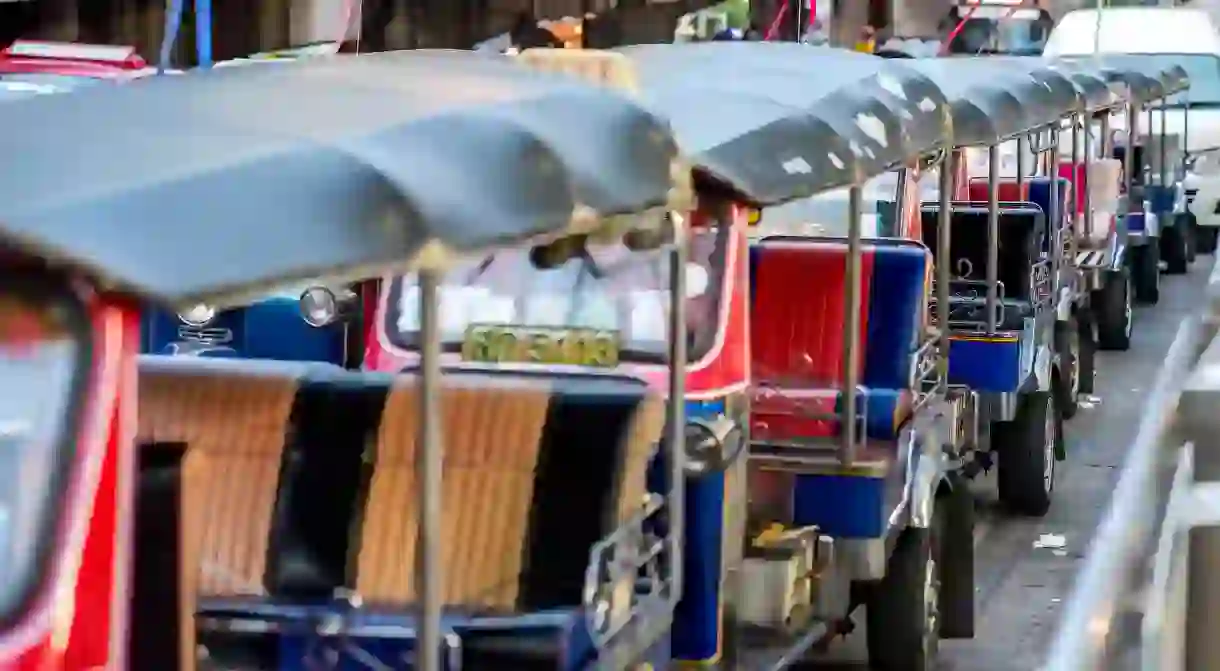How To Navigate Transport in Cambodia

Cambodia is a country that can be characterised by its organised chaos. While adding to its charm, this trait can make getting around daunting. Whether it be navigating the bustling streets of the capital, organising a trip across the country or figuring out how to get up Bokor Mountain, here’s how to tackle transport in the Kingdom of Wonder.
Tuk Tuk
Tuk tuk is the most popular mode of transport in Cambodia, with the two-wheel carriages being pulled out by motorbike. Again, there’s no shortage of tuk tuks — although the number drastically decreases after about 10pm — waiting to take tourists about, usually at heavily inflated prices.
Local tip: Make sure you negotiate a price before getting in the tuk tuk to avoid any awkward over-charging issues when you alight. Also, carry around a pocketful of small dollar bills and riel because it’s rare your driver will have change.

Motodop
Motodop – or motorbike taxis – can be found on pretty much every street corner – and drivers may be snoozing in the dappled shade until the next customer arrives. It may not be the safest mode of transport, especially at night when booze-fuelled drivers getting behind the wheel is common, but it’s definitely the most fun, and being able to weave in and out of the traffic makes it the quickest. It’s also easy on the pocket.
Local tip: Most moto drivers don’t speak English and won’t know where they’re going, regardless of whether they claim to, so be prepared to give directions. Most don’t carry spare helmets either, so safety first and get your hands on your own.

Local bus
Until recently, public transport in Cambodia was non-existent. However, a few years ago, the capital welcomed its first bus service in decades. While it’s mainly used by locals and runs limited routes that take in Phnom Penh’s clogged up roads, tickets cost 1,500 riel ($0.38) for a single journey, and by downloading the Stops Near Me app, users can see the route and timetable.
Local tip: The bus service now operates eight routes, covering major swathes of central Phnom Penh, extending to the outskirts, so this option can be a fun way to take a day trip out of the city.

National bus
Just like with tuk tuks, there is no shortage of buses and minivans waiting to take you to whichever corner of Cambodia it is you’re headed. Bear in mind that these range from the downright unsafe, to more comfortable affairs that boast WiFi and AC.
Local tip: Cambodia’s roads are the country’s biggest killers and taking a bit of time to choose how you get around is worth it. CamboTicket is a relatively recent addition to the market and enables users to see reviews based on safety, reliability and service, and they can book online.

Train
After a 14-year hiatus, Cambodia’s rail service was re-instated in 2016, connecting the capital with Sihanoukville, via Takeo and Kampot. While offering a scenic alternative to the bus or taxi, it’s long — taking more than seven hours. The service also only runs on weekends.
Local tip: If you fancy hiring a motorbike and taking it with you on your travels, then motorbikes and bicycles can be transported for a $5 fee.

Private taxi
While more private taxis for hire can be seen floating around the capital, private cars are another option for getting around the country. These can be arranged through your hotel or any of the many travel agents that dot tourist hubs. These are quicker than the buses but, of course, more expensive. For example, a trip from Phnom Penh to Kampot will set you back about $40.
Local tip: Share taxis offer a cheaper alternative, but be warned, as you’ll find yourself wedged in between a family of eight, a few chickens and boxes and boxes of food.
Ride-hailing apps
The past few years have seen ride-hailing apps start to rule the roads, to the detriment of struggling tuk tuk drivers. Homegrown PassApp dominates the market, with its rickshaw-style tuk tuks flooding the capital and Siem Reap’s roads. Costing a fraction of the price of tuk tuks, without the hassle of haggling, these are quickly becoming the number one option for many.
Local tip: International giant Uber entered the market in 2017 but was recently taken over by Grab, offering taxi transport. Another local player is Exnet Taxi Cambodia, which also offers transport in the form of cars and vans.














